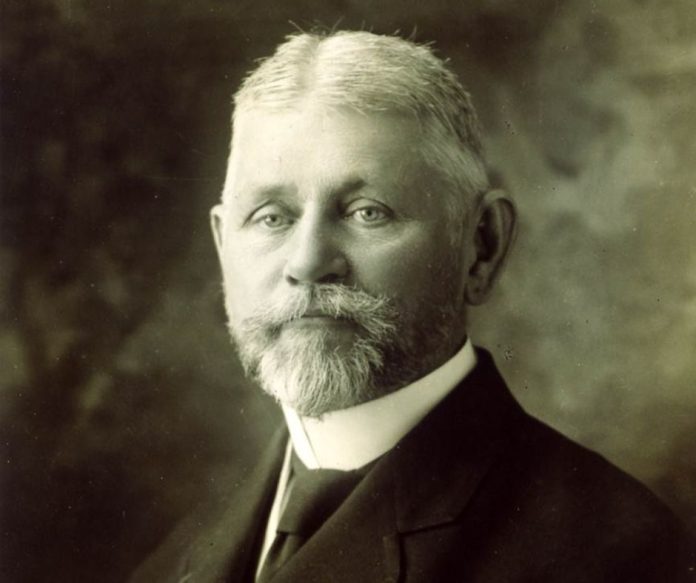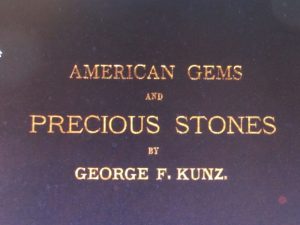
George Frederick Kunz, remembered as America’s first gemologist, was born in New York City in 1856, a time when America knew little about gems and the science of gemology did not yet exist.

Almost everyone interested in gemstones, whether from the gemological, historical or metaphysical perspectives, has read, or at least heard of, George Frederick Kunz’s book The Curious Lore of Precious Stones. Published 110 years ago, this classic is still being reprinted today.
Over his long career, Kunz would introduce jewelers to semiprecious colored gems; write more than 400 gem-related articles, books and reports; assemble world-class mineral collections; cofound the nation’s oldest mineral club; and compile the first formal accounts of birthstones and the metaphysical aspects of gems. Impressive achievements for a largely self-educated man.
The Young Rockhound
As a teenager in Manhattan and nearby Hoboken, New Jersey, Kunz collected minerals wherever he could find them, often at bridge and railroad construction sites. After attending public schools, he took night classes at Manhattan’s Cooper Institute, although he did not graduate. Despite being limited in his formal education, he read everything available about minerals to complement his already proficient field-collecting skills.
Kunz was still a teenager when he sold his 4,000-specimen mineral collection to the University of Minnesota for $400 ($8,000 in 2023 dollars). He later wrote that the sale wasn’t “so much for the money but to mark myself in the eyes of the world as a real collector.”

Wikimedia Commons
Tiffany & Co.
In the 1870s, American and European jewelers focused mainly on the “big four” gems — diamonds, rubies, sapphires and emeralds. Kunz, however, was more interested in semiprecious gemstones or, as he later wrote, the “sea-green depths of tourmaline, the watery-blue of aquamarine, the red blood-cups of garnet, the misty nebula of moonstone.”
At that time, the nation’s most prestigious jeweler was then New York City’s Tiffany & Co. Founded by Charles Lewis Tiffany in 1837, the company dealt exclusively in the “big four” gems. But that began to change in 1875 when 19-year-old Kunz showed Tiffany a fine specimen of green tourmaline, then persuaded the jeweler to buy it, cut it into gems and fashion an experimental line of jewelry. To Tiffany’s surprise, the collection quickly sold out.
Kunz’s meeting with Charles Tiffany was a turning point in America’s experience with gems. Gem fashions now changed rapidly once Tiffany introduced the public to semi-precious gemstone jewelry. In 1879, Tiffany hired Kunz as his gemstone expert, a position he would hold for the rest of his life. Kunz’s many responsibilities included finding sources of the semiprecious, colored gemstones that now captured his employer’s—and the public’s—attention.

Steve Voynick
George Frederick Kunz the Writer
Kunz began publishing gem-related articles in 1881. Two years later he wrote a report titled “American Gems and Precious Stones” for the United States Geological Survey’s (USGS) Mineral Resources of the United States, an annual, book-length publication.
Kunz’s reports on domestic gemstone discoveries and production for the USGS established the credibility of gemstones as a mineral resource and encouraged gemstone prospecting. Through these annual reports, Kunz also built a national network of correspondents that included prospectors, miners, geologists, mineralogists and mineral collectors. The USGS also appointed Kunz a “special agent” and regularly published his gemstone reports in Mineral Resources of the United States for 50 years.
In 1886, Kunz cofounded the New York Mineralogical Club. Still in existence today as the nation’s oldest, continuously active mineral club, the NYMC has been the model for the subsequent founding of hundreds of similar clubs across the nation. Kunz’s first book, Gems and Precious Stones of North America, published in 1890, utilized his research for his Mineral Resources of the United States reports.
The World-Class Collector
Through his work at Tiffany & Co., Kunz became acquainted with prestigious customers, among them the wealthy financier John Pierpont Morgan, a prominent collector of art, antiques and gemstones. In 1888, Morgan commissioned Kunz to assemble a gemstone collection for international exhibition. The 382-specimen collection that Kunz put together won two gold medals at the 1889 Exposition Universelle in Paris.
In 1891, jointly financed by Morgan and Tiffany, Kunz traveled to Russia’s Ural Mountains to locate mine sources of gemstones. While in the Urals, Kunz acquired a quantity of demantoid, the green variety of andradite and the rarest and most valuable of the garnet gemstones. He also purchased newly mined alexandrite, the color-change variety of chrysoberyl. Charles Tiffany’s later successful marketing of demantoid and alexandrite in his Art Noveau and Art Deco jewelry styles kept both stones from gemological obscurity.
In 1900, Morgan commissioned Kunz to assemble another world-class collection of gems and minerals—the 4,000-specimen Second Tiffany-Morgan Collection. The following year, Morgan, again relying on Kunz’s collecting expertise, paid $100,000 (roughly $2 million in 2023 dollars) to acquire Philadelphia industrialist Clarence S. Bement’s spectacular 12,300-specimen collection. Morgan later donated these Kunz-assembled collections to New York City’s American Museum of Natural History.
The Tiffany Yellow DiamondSoon after 23-year-old George Frederick Kunz began work at Tiffany & Co., he received a daunting assignment—to design and supervise the cutting of a 287.42-carat, canary-yellow, South African diamond that Charles Tiffany had purchased for $18,000 ($500,000 in 2023 dollars). Kunz and other experts studied the stone for a year before deciding on a modified, square-antique-brilliant cut with 82 facets, 24 more than the traditional 58-facet cut. Kunz’s unconventional and rather daring approach successfully maximized the stone’s brilliance.  The resulting 128.54-carat gem, now famed as the “Tiffany Yellow Diamond” and valued at $30 million, has since been worn by only four women, among them actress Audrey Hepburn in a 1961 promotion for the movie Breakfast at Tiffany’s; Lady Gaga at the 2019 Academy Awards ceremony; and Beyoncé in a 2021 Tiffany & Co. advertisement. As part of the enduring legacy of George Frederick Kunz, this spectacular diamond has appeared in various settings and is permanently displayed at Tiffany’s flagship store in New York City. |
Birthstones & the Metaphysical
In 1891, Tiffany & Co. published Kunz’s Natal Stones: Sentiments and Superstitions Connected with Precious Stones, which traced the ancient Biblical and Hindu origins of birthstones, and documented what had for centuries been only loose tradition. Although just 36 pages long, Natal Stones heightened public interest in birthstones and sharply increased sales of Tiffany’s birthstone jewelry. In 1912, the National Association of Jewelers of America formalized Kunz’s birthstone list. Tiffany & Co. regularly reprinted updated editions of Natal Stones until 1931; modern reprints continue to be available today.
Largely at Tiffany’s expense, Kunz amassed a huge, personal gemological library; while most of these volumes addressed the mineralogical aspects of gemstones, a significant number of rare works dealt with the historical, healing, occult, spiritual, religious and metaphysical aspects of gems.
In 1913, many of these volumes served as Kunz’s research base for The Curious Lore of Precious Stones, the first comprehensive treatment of gem lore. Widely marketed in North America and Great Britain, this enormously popular book boosted sales of gems and jewelry, and greatly stimulated interest in the metaphysical aspects of gems. Although first editions currently sell for as much as $1,000, affordable reprints are still sold today.

Steve Voynick
Yogo Sapphires & Kunzite
Prospectors, miners, jewelers and collectors often mailed Kunz specimens to identify. “It would perhaps seem improbable that, sitting at a desk in New York, one [could] discover a gem mine in Montana, yet that is just what happened to me,” Kunz later recalled. “. . . upon examination I found certain crystals to which little attention had been paid, but which I discovered to be fine blue sapphires.” Thanks to Kunz’s identification, Montana’s Yogo Gulch became the Western Hemisphere’s greatest source of gem sapphire.
Kunz also received a package of pinkish-purple, transparent crystals from a Pala, California, miner who needed help with identification. After Kunz identified the crystals as a new color variety of spodumene, members of the New York Academy of Science named this variety “kunzite” in Kunz’s honor.
In 1910, after identifying a violet-pink stone from Madagascar as a new color variety of beryl, Kunz named it “morganite” for his longtime friend and benefactor John Pierpont. Morgan.
Respect and Recognition
Kunz despised jewelers who took advantage of an unsuspecting public by passing off altered or look-alike gems as the real thing and enjoyed posing as an average jewelry customer. He was once shown a necklace with gems that the jeweler described as “exceptionally fine.”
“Really, well, after all, that’s not a high price for it—I paused, the dealer beamed—if it were genuine. I leaned over the table, lifted and dropped the necklace disdainfully. What do you mean asking such a price for a flagrant forgery?”
As Kunz’s notoriety grew, honorary degrees compensated for his lack of formal education. He received a master’s degree from New York City’s Columbia University; a doctor-of-philosophy degree from Germany’s University of Marburg; and a Ph.D. from Knox College in Galesburg, Illinois. Kunz proudly used his academic designations in all his later articles and books.
In a 1928 interview with The Saturday Evening Post, Kunz explained what had sustained his interest in gems and minerals for more than 60 years: “Every boy has his passions—his collection of stamps or coins or marbles or what not, and the only difference between another boy’s and mine was that I never outgrew it.”
George Frederick Kunz’s Legacy
Kunz remained active with Tiffany & Co. until his death in 1932 at age 75. While making many contributions to the world of gems and minerals, Kunz had also succeeded financially. His estate was valued at $114,000—the equivalent of more than $2 million today.
Kunz’s bestowed his final gift posthumously in 1933 when his estate sold his personal gemological and mineralogical library of several thousand rare books, pamphlets and articles to the USGS for the token sum of one dollar. Today, the Kunz Collection is available to researchers at the USGS Library in Reston, Virginia.
Kunz’s obituary in Science magazine concluded with “. . . it is doubtful if [anyone] ever lived a richer or more interesting life.” And when it came to gemstones and gems, that was probably true. Interestingly, the word “gemologist” replaced the term “gem expert” almost immediately after Kunz’s death. That was fitting, for George Frederick Kunz, as America’s first gemologist, had advanced the world of gems culturally, commercially, scientifically, and metaphysically.
This story about George Frederick Kunz previously appeared in Rock & Gem magazine. Click here to subscribe. Story by Steve Voynick.














